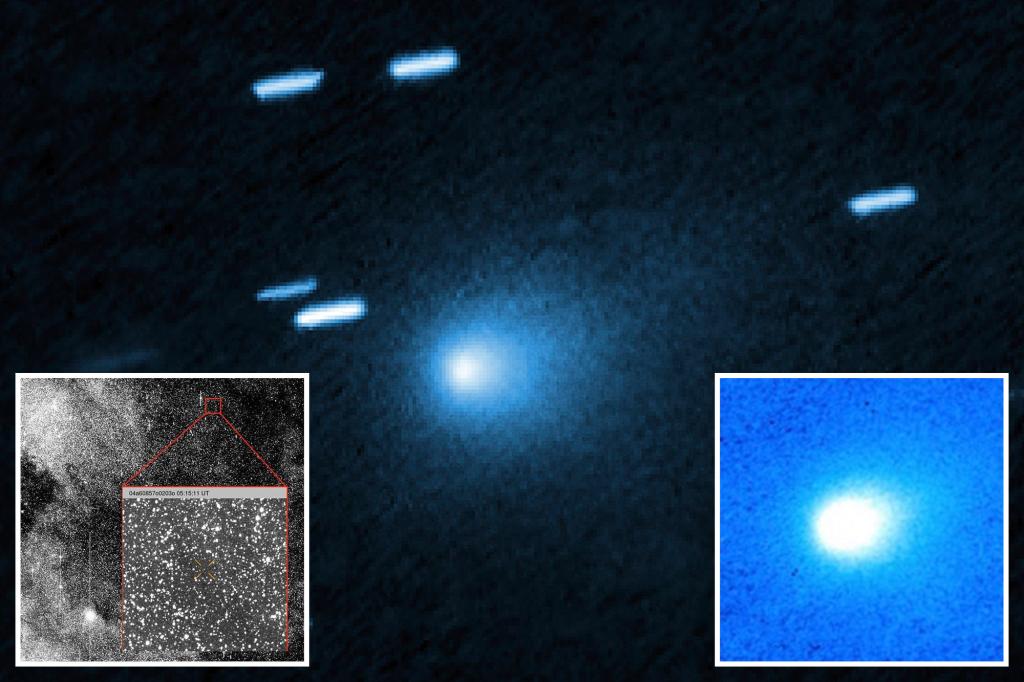Interstellar object 3I/ATLAS — which is zooming through our inner solar system — appears to be emitting its own light, according to Harvard astrophysicist Avi Loeb.
The observation by Loeb, if verified, would contradict NASA’s classification of the Manhattan-sized object as a comet, the scientist argues in a new blog post.
An image of 3I/ATLAS taken by the Hubble Telescope on July 21, according to NASA. AP
Loeb and a colleague analyzed photos released by NASA of the object in determining that the source of its glow is likely not from the sun.
The astrophysicist wrote the “brightness profile around 3I/ATLAS implies that the nucleus dominates the observed light.”
“The simplest interpretation is that the nucleus of 3I/ATLAS produces most of the light,” he wrote in the paper published Sunday.
The level of light observed on 3I/ATLAS could be achieved “from a source diameter smaller than 100 meters,” according to Loeb.
This shift in understanding the light source would also mean that 3I/ATLAS is quite smaller than initially thought, and more comparable in size to the two other known interstellar objects, Oumuamua and Borisov.
Images taken by the Hubble Telescope show the object
glowing at its front end and not having any comet tail. Jewitt et al. 2025
If 3I/ATLAS were reflecting light, it would mean the object was 12 miles long, which is improbable, according to the astrophysicist.
Loeb speculated that the nucleus of the object could in fact be nuclear — and possibly an engine crafted by an alien people.
“A natural nuclear source could be a rare fragment from the core of a nearby supernova that is rich in radioactive material. This possibility is highly unlikely, given the scarce reservoir of radioactive elements in interstellar space,” Loeb wrote.
The trajectory of the object brings it through our inner Solar System in perfect position to possibly observe Earth. NASA/JPL-Caltech
“Alternatively, 3I/ATLAS could be a spacecraft powered by nuclear energy, and the dust emitted from its frontal surface might be from dirt that accumulated on its surface during its interstellar travel,” Loeb conjectured, adding, “This cannot be ruled out, but requires better evidence to be viable.”
Loeb argued this conclusion is bolstered by 3I/Atlas’ “fine-tuned trajectory.”
That suspicious trajectory will see the object blocked from Earth’s view by the sun just as it will get its closest to our pale blue dot.
It will also make passes of Mars and Jupiter, adding to Loeb’s suspicions that this could be a reconnaissance mission conducted by an inquisitive and interstellar intelligence.
The object was first discovered by the NASA-funded ATLAS survey
telescope in Chile on July1, according to NASA. ATLAS/University of Hawaii/NASA
Loeb is now calling for the Mars Reconnaissance Orbiter to use its HiRISE camera to make observations of 3I/ATLAS when it passes by 17 million miles away in the first week of October.
He has also called for NASA to direct its Juno craft, currently orbiting Jupiter, to make what observations it can when 3I/ATLAS passes nearby next spring.
NASA has maintained that 3I/ATLAS is merely a comet.
Loeb pointed out to The Post that earlier this year NASA claimed to discover a new asteroid which turned out to merely be the Tesla Roadster that Elon Musk launched into space.

